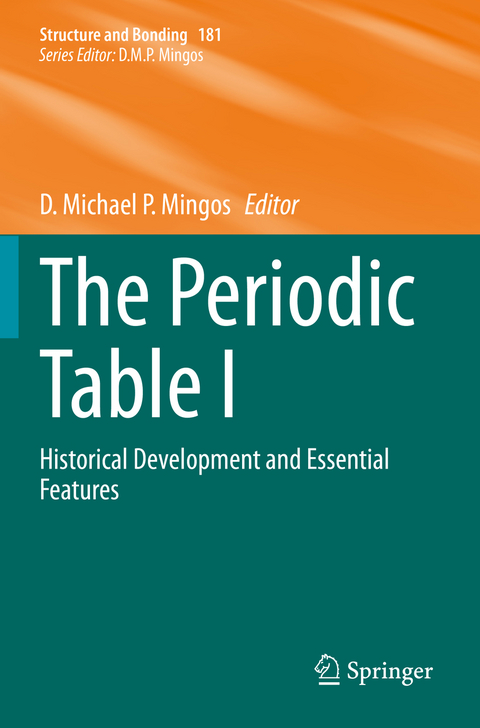
The Periodic Table I
Springer International Publishing (Verlag)
978-3-030-40027-9 (ISBN)
As 2019 has been declared the International Year of the Periodic Table, it is appropriate that Structure and Bonding marks this anniversary with two special volumes.
In 1869 Dmitri Ivanovitch Mendeleev first proposed his periodic table of the elements. He is given the major credit for proposing the conceptual framework used by chemists to systematically inter-relate the chemical properties of the elements. However, the concept of periodicity evolved in distinct stages and was the culmination of work by other chemists over several decades. For example, Newland's Law of Octaves marked an important step in the evolution of the periodic system since it represented the first clear statement that the properties of the elements repeated after intervals of 8. Mendeleev's predictions demonstrated in an impressive manner how the periodic table could be used to predict the occurrence and properties of new elements. Not all of his many predictions proved to be valid, but the discovery ofscandium, gallium and germanium represented sufficient vindication of its utility and they cemented its enduring influence. Mendeleev's periodic table was based on the atomic weights of the elements and it was another 50 years before Moseley established that it was the atomic number of the elements, that was the fundamental parameter and this led to the prediction of further elements.
Some have suggested that the periodic table is one of the most fruitful ideas in modern science and that it is comparable to Darwin's theory of evolution by natural selection, proposed at approximately the same time. There is no doubt that the periodic table occupies a central position in chemistry. In its modern form it is reproduced in most undergraduate inorganic textbooks and is present in almost every chemistry lecture room and classroom.
This first volume provides chemists with an account of the historical development of the Periodic Table and an overview of how the Periodic Table has evolved over the last 150 years. It also illustrates how it has guided the research programmes of some distinguished chemists.
lt;p>Michael Mingos was born in Basra, Iraq in 1944 and was educated in England (Manchester, B.Sc. in Chemistry 1965) and University of Sussex (D.Phil, 1968). He has held academic posts at QMC, Oxford (Keble College), Imperial College, St Edmund Hall (Principal,1999-2009). His theoretical research has resulted in generalisations which have greatly influenced the development and teaching of modern inorganic chemistry. Specifically the Wade-Mingos Rules which rationalise the structures of polyhedral inorganic molecules and the Green-Davies-Mingos Rules, which account for some of the nucleophilic reactions of organometallic compounds. His group has experimentally verified some of his theoretical predictions, for example an icosahedral molecule containing gold atoms -which is relevant for understanding the metal's nano-technological possibilities. He has also contributed to the understanding of the bonding properties of nitric oxide, an important cellular signalling molecule involved in many physiological processes and pioneered the acceleration of chemical reactions using microwave energy. He was elected the Royal Society in 1992 and the European Academy of Sciences in 2017. He holds honorary doctorates from Sussex and Manchester Universities and received many prizes - the most recent was the Blaise Pascal Medal in 2017
The Discovery of the Elements in the Periodic Table.- Chemical Valency: Its impact on the proposal of the Periodic Table and some thoughts about its current significance.- Periodic trends revealed by photoelectron studies of transition metal and lanthanide compounds.- The History, relevance and applications of the Periodic Table in geochemistry.- Chemistry at the Edge of the Periodic Table; The Importance of Periodic Trends on the Discovery of the Noble Gases and the Development of Noble-Gas Chemistry.- The Periodic Table as a Career Guide: A Journey to Rare Earths.- Discovery of the Transuranium Elements Inspired the Rearrangement of the Periodic Table and the Approach for finding New Elements.
| Erscheinungsdatum | 07.02.2021 |
|---|---|
| Reihe/Serie | Structure and Bonding |
| Zusatzinfo | XI, 265 p. 80 illus., 46 illus. in color. |
| Verlagsort | Cham |
| Sprache | englisch |
| Maße | 155 x 235 mm |
| Gewicht | 433 g |
| Themenwelt | Naturwissenschaften ► Chemie ► Anorganische Chemie |
| Schlagworte | batteries • Bio-inorganic Chemistry • Chemical Valency • d and s block elements • Homogeneous catalysis • lanthanides and actinide • metal ions • Noble Gases • periodic table • Photoelectron studies • solid state chemistry • Zeolites |
| ISBN-10 | 3-030-40027-1 / 3030400271 |
| ISBN-13 | 978-3-030-40027-9 / 9783030400279 |
| Zustand | Neuware |
| Haben Sie eine Frage zum Produkt? |
aus dem Bereich


